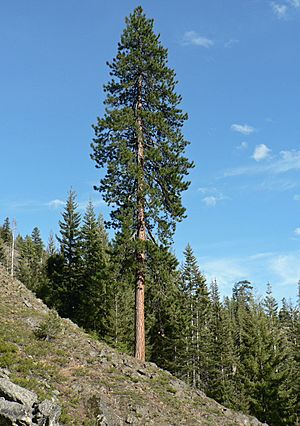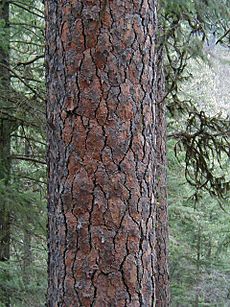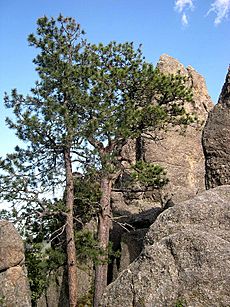Ponderosa pine facts for kids
Quick facts for kids Ponderosa pine |
|
|---|---|
 |
|
| Pinus ponderosa subsp. ponderosa | |
| Conservation status | |
| Scientific classification | |
 |
|
| Natural range of Pinus ponderosa
green - P. ponderosa ssp. ponderosa
red - P. ponderosa ssp. benthamiana
blue - P. ponderosa ssp. scopulorum
yellow - P. ponderosa ssp. brachyptera
|
The Ponderosa Pine (scientific name: Pinus ponderosa) is a very large pine tree. It's also known by other names like bull pine or western yellow-pine. This amazing tree grows naturally in the mountains of western North America.
The Ponderosa Pine is the most common pine tree found across North America. You can find it from British Columbia in Canada, all the way south and east through 16 western U.S. states. People have also planted it in other parts of the world, like Europe and New Zealand.
A Scottish plant expert named David Douglas first wrote about this tree in 1826. He was in eastern Washington state, near a city called Spokane. Spokane even made the Ponderosa Pine its official city tree! Douglas later realized it was a new type of pine and named it Pinus ponderosa because its wood was so heavy. In 1836, another Scottish plant expert, Charles Lawson, officially named and described the tree. In 1949, the Ponderosa Pine became the official state tree of Montana.
Contents
What Does a Ponderosa Pine Look Like?

The Ponderosa Pine is a big coniferous tree. This means it's an evergreen and has cones. One way to tell it apart from other trees is by its bark.
Older Ponderosa Pines have bark that looks yellow to orange-red. It forms large, wide plates with dark cracks. Younger trees have darker, blackish-brown bark. Early loggers used to call these younger trees "blackjacks."
The Ponderosa Pine has bright-green needles. This is a good way to tell it apart from the Jeffrey pine, which has blue-green needles. The needles grow in small bundles called fascicles. The needles can be different lengths depending on where the tree grows:
- Some have very long needles, about 19.8 centimeters (7.8 inches) long.
- Others have shorter, sturdier needles, around 9.2 to 14.4 centimeters (3.6 to 5.7 inches) long.
Some people say the bark of the Ponderosa Pine smells like turpentine. Others say it doesn't have a strong smell at all. Some even say it smells like vanilla if you sniff it from a crack in the bark! The Jeffrey pine is known to have a much stronger smell than the Ponderosa Pine.
How Tall Do Ponderosa Pines Grow?
Ponderosa Pines can grow to be very tall trees! The National Register of Big Trees lists one Ponderosa Pine that is 71.6 meters (235 feet) tall. That's about as tall as a 20-story building!
In 2011, a Ponderosa Pine in Oregon was measured with a laser. It was found to be an amazing 81.85 meters (268.5 feet) tall. This makes it the second tallest known pine tree, right after the sugar pine.
Growing Ponderosa Pines
People often plant Ponderosa Pines in parks and large gardens. They are grown as "ornamental plants" because they look beautiful.
Ponderosa Pines and Science Experiments
In 1953, during a nuclear test called Operation Upshot–Knothole, scientists used Ponderosa Pines for an experiment. The United States Forest Service cut down 145 trees and planted them at the Nevada Test Site. They wanted to see what a nuclear blast wave would do to a forest. The trees were partly burned and blown over by the blast.
Where Do Ponderosa Pines Live?

The Ponderosa Pine is a very common tree in many areas. It often grows in mountainous places, like most western pines. However, you can also find it along the Niobrara River in Nebraska.
You'll see Ponderosa Pines in places like:
- The Willamette Valley in Oregon.
- The Okanagan Valley and Puget Sound areas in Washington.
- Throughout valleys in British Columbia, Canada.
- In the Black Hills of South Dakota, where they cover 80% of the land.
- On the foothills and mid-height peaks of the Rocky Mountains, Cascade Range, and Sierra Nevada.
- In Arizona, especially on the Mogollon Rim.
The Ponderosa Pine is very good at surviving fires. Natural fires happen every 5 to 10 years in areas where these trees grow. These fires are usually not very intense and help keep the forest healthy.
Many animals interact with the Ponderosa Pine:
- The caterpillars of a moth called Chionodes retiniella eat only Ponderosa Pine needles.
- Blue stain fungus can harm the trees. It's carried by beetles like the mountain pine beetle.
- Squirrels, chipmunks, quail, and grouse eat the seeds.
- Clark's nutcracker also eats the seeds.
- Mule deer like to eat the young Ponderosa Pine seedlings.
Ponderosa Pine Health Issues
Like all living things, Ponderosa Pines can get sick or be affected by pests. Some of the things that can harm them include:
- Different types of fungi, such as Armillaria and Phaeolus schweinitzii.
- Dwarf mistletoe, which is a parasitic plant.
- Various insects like the western pine beetle and mountain pine beetle. These beetles can cause a lot of damage by tunneling under the bark.
Different Kinds of Ponderosa Pines
Scientists have found that there are five different types, or "subspecies," of Ponderosa Pine. These types have slightly different features and are adapted to different climates. Some scientists used to think these were completely separate species, but now they are mostly considered subspecies.
Here are some of the main subspecies and where they grow:
- Southwestern Ponderosa Pine (Pinus ponderosa subsp. brachyptera): Found in places like southern Colorado, Utah, New Mexico, and Arizona. It likes hot weather with both wet winters and summers.
- Pacific Ponderosa Pine (Pinus ponderosa subsp. critchfieldiana): Grows in western Washington, Oregon, and California. It prefers hot, dry summers and mild, wet winters with lots of snow in the mountains.
- Columbia Ponderosa Pine (Pinus ponderosa subsp. ponderosa): Found in southeastern British Columbia, eastern Washington, Oregon, Idaho, and parts of Montana. It likes cool, moist summers and very cold, snowy winters.
- Central High Plains Ponderosa Pine (Pinus ponderosa subsp. readiana): Lives in southern South Dakota, northern Nebraska, and eastern Colorado. It experiences hot, dry, windy summers and very cold, wet winters.
- Rocky Mountains Ponderosa Pine (Pinus ponderosa var. scopulorum): Grows in Montana, North and South Dakota, Wyoming, Nebraska, Colorado, Utah, and eastern Nevada. It has warm, dry summers and very cold, fairly dry winters.
Scientists can tell these subspecies apart by looking at things like:
- How many years their needles stay green.
- The length and thickness of their needles.
- How many needles are in each bundle.
- The angle of their branches.
- The size and shape of their seed cones.
- The color of their mature cones.
| Common name | Pacific | Columbia | Rocky Mountains | Southwestern | Central High Plains |
|---|---|---|---|---|---|
| Scientific name | P. p. critchfieldiana | P. p. ponderosa | P. p. scopulorum | P. p. brachyptera | P. p. readiana |
| Years needles remain green | 3.9±0.25 | 4.7±0.14 | 5.7±0.28 | 4.3±0.18 | 4.7±0.18 |
| Foliage length on branch (cm) | 25.1±2.4 | 26.2±2.2 | 21.1±1.7 | 21.8±2.7 | 42.2±6.7 |
| Needle length (cm) | 19.8±0.44 | 16.8±0.29 | 11.2±0.27 | 14.7±0.45 | 15.6±0.57 |
| Needles per fascicle | 3.0±0.00 | 3.0±0.00 | 2.6±0.06 | 3.0±0.03 | 2.4±0.11 |
| Needle thickness | 45.9±0.49 | 47.8±0.51 | 46.4±0.68 | 44.8±0.87 | 49.7±0.61 |
| Branches per whorl | 4.4±0.13 | 3.7±0.11 | 3.0±0.17 | 3.4±0.25 | 2.3±0.11 |
| Branch angle (° from vertical) | 56±1.8 | 51±1.7 | 50±2.3 | 48±3.1 | 36±1.9 |
| Seed cones length (mm) | 101.4±2.48 | 88.7±1.24 | 70.7±2.20 | 74.9±2.51 | 71.1±2.46 |
| Seed cones width (mm) | 77.1±1.35 | 71.6±0.73 | 61.5±1.08 | 62.6±1.77 | 63.3±2.18 |
| Seed cone form W/L | 0.80±0.03 | 0.84±0.03 | 0.90±0.02 | 0.86±0.02 | 0.90±0.03 |
| Seed length (mm) | 7.5±0.08 | 7.6±0.16 | 6.3±0.09 | 6.4±0.18 | 7.0±0.12 |
| Seed width (mm) | 4.9±0.05 | 4.9±0.08 | 4.1±0.05 | 4.3±0.09 | 4.5±0.10 |
| Seed + wing length (mm) | 32.3±0.58 | 24.8±0.62 | 22.9±0.63 | 23.3±0.68 | 23.1±0.78 |
| Mature cone color | apple green to yellow green | green & red-brown to dark purple | green & red-brown to dark purple | green & red-brown to dark purple |
Symbols and State Trees
The Ponderosa Pine is a special tree in Montana. In 1908, Montana schoolchildren voted for their favorite tree to be the state tree. They chose the Ponderosa Pine! However, it wasn't until 1949 that it officially became Montana's state tree.
Ponderosa Pines in New Zealand
In New Zealand, the Ponderosa Pine is sometimes called a "wilding pine." This is because it can spread very easily and take over areas of land. When this happens, it can prevent native New Zealand plants from growing in those places.
Images for kids
See also
 In Spanish: Pino ponderosa para niños
In Spanish: Pino ponderosa para niños



